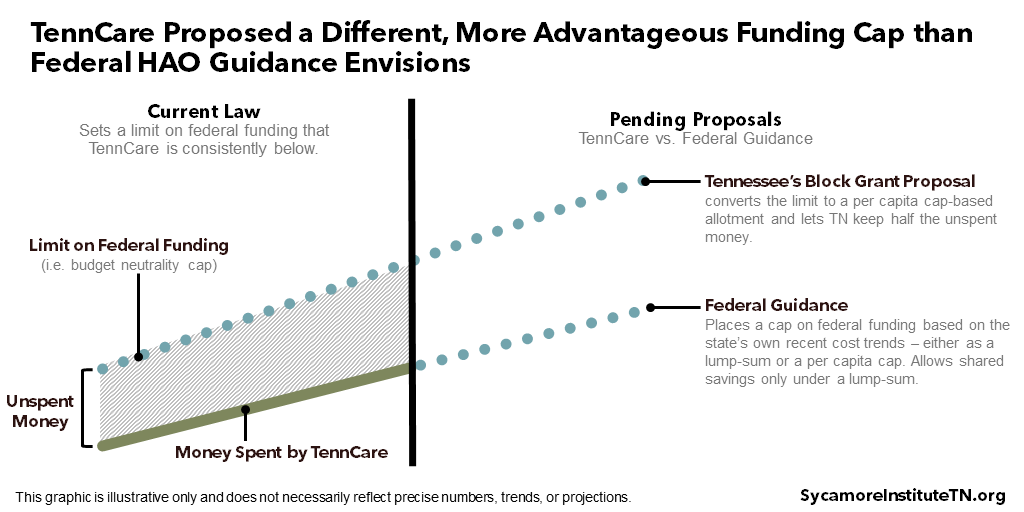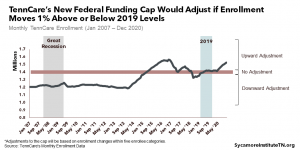
Yesterday, the federal government released its guidance for states interested in applying for a Medicaid block grant or per capita cap. It’s clear that the plan Tennessee proposed last year will not be approved as-is under this particular set of rules. However, state and federal officials have both hinted that Tennessee’s plan may still have a separate path to approval. (1) (2)
Since the new federal guidance may offer clues about where negotiations over Tennessee’s plan go from here, let’s see how the two plans compare. For a side-by-side comparison, see Table 1 in the pdf version of this report.
Editor’s Note: This post may be updated with more details as we digest the new guidance.
Key Takeaways
- TennCare’s proposal includes few (if any) enrollees who are eligible for the type of demonstration program outlined in new federal guidance.
- The federal funding caps proposed by TennCare are substantively different and more advantageous for Tennessee than what the federal guidance envisions.
- The federal government offers flexibilities that are largely in line with those proposed by TennCare.
- Even if Tennessee’s plan still has a separate path to approval, it’s likely to undergo significant changes during negotiations with federal regulators.
What is the Federal Guidance?
The federal Medicaid agency (i.e. CMS) released guidelines for state Medicaid programs interested in applying for a new “Healthy Adult Opportunity” (HAO) demonstration. The HAO demonstration would cap federal Medicaid funding to states for certain enrollees in exchange for more administrative flexibility. The guidance lays out a set of parameters that federal regulators would consider in reviewing these proposals — “reflect[ing] the conditions that CMS expects will be necessary to approve an application to implement an HAO demonstration.” (3)
How the Guidance Compares to TennCare’s Proposal
When compared with TennCare’s proposal (4), the HAO guidance proposes (3):
- Fundamentally different approaches to how the funding caps are set and the types of enrollees that could be affected.
- Similar administrative flexibilities.
- More specific requirements around transparency and performance monitoring.
Affected Populations
The guidance largely limits the potential HAO demonstration population to adults eligible under Medicaid expansion. It excludes children, adults over 65, anyone eligible based on disability or the need for long-term services and supports, and anyone who is already eligible under the state’s Medicaid plan. What is left is largely the group of non-disabled adults eligible under the Affordable Care Act’s (ACA) expanded eligibility criteria.
TennCare’s proposal includes few (if any) enrollees who could be included in an HAO demonstration. Tennessee’s proposal applies to nearly all current TennCare enrollees, and the state has not expanded Medicaid eligibility under the ACA. The only remaining group within Tennessee’s proposal that may qualify under the HAO demonstration appears to be a small population for which enrollment closed in 2016. (5) If state policymakers wanted to tap into the HAO opportunity, they would likely have to be open to making at least some new people eligible for Medicaid.
Figure 1

Federal Funding Caps
The federal funding caps proposed by TennCare are substantively different and more advantageous for Tennessee than what the HAO guidance envisions. The guidance offers the option of either a per capita cap that accounts for changes in enrollment or an aggregate cap that does not. Either approach would cap funding based on each state’s own spending trends. In contrast, TennCare proposes a per capita cap based on national spending trends — effectively extending the current “budget neutrality” cap to which the state is already subject (Figure 1). Because of the state’s relatively low costs, TennCare is all but guaranteed to meet its proposed cap. However, it may have a harder time meeting caps designed to keep state spending at or below its own relatively low recent trends.
Shared Savings
The shared savings offered in the federal guidance differs from that proposed by TennCare. TennCare’s plan would let the state tap shared savings below its proposed cap and without the need for state match dollars. The HAO demonstration would allow shared savings only for states choosing a lump-sum cap that does not account for changes in enrollment. In order to access those dollars, the state would have to spend its own money to meet existing Medicaid match requirements.
Administrative Flexibilities
The HAO guidance proposes flexibilities that are largely in line with those proposed by TennCare. For example, it seeks to let states tap into existing flexibilities without getting prior federal approval (e.g. to change the amount, duration, and scope of covered benefits). It would also allow states to use a drug formulary like those used in the private market without losing federally-required discounts from the drug industry.
Transparency and Performance
The HAO guidance lays out more specific requirements for transparency and performance monitoring than those proposed by TennCare. TennCare’s proposal leaves the door open for specific requirements in these areas but does not fill in the details itself. The federal guidance, on the other hand, lays out certain requirements for using the offered flexibilities — including things like public notifications, comment periods, quarterly implementation plan updates, performance reporting, evaluations, and establishing alternative procedures for managed care plans.
What It Means for Tennessee
TennCare’s proposal differs from the standards laid out in the HAO guidance in a number of substantive ways. Public statements suggest, however, that TennCare’s proposal is not yet dead and may still get considered separately from the new guidance. Even so, if the HAO guidance reflects the goals and priorities of federal regulators when thinking about federal funding caps, we can expect significant changes to TennCare’s proposal if it does indeed move forward.
References
Click to Open/Close
- TennCare. TennCare Comments on Healthy Adult Opportunity Guidance. [Online] January 30, 2020. https://www.tn.gov/tenncare/news/2020/1/30/tenncare-comments-on-healthy-adult-opportunity-guidance.html.
- Kelman, Brett and Ebert, Joel. TennCare and the Trump Administration Have Drastically Different Block Grant Plans. The Tennessean. [Online] January 30, 2020. https://www.tennessean.com/story/news/health/2020/01/30/tenncare-and-trump-administration-have-very-different-block-grant-plans/4609948002/.
- Lynch, Calder. Letter to State Medicaid Directors Re: Healthy Adult Opportunity (SMD# 20-001). Centers for Medicare and Medicaid Services, Center for Medicaid and CHIP Services. [Online] January 30, 2020. https://www.medicaid.gov/sites/default/files/Federal-Policy-Guidance/Downloads/smd20001.pdf.
- Division of TennCare. Amendment 42: Modified Block Grant and Accountability. [Online] November 20, 2019. https://www.tn.gov/content/dam/tn/tenncare/documents2/Amendment42FinalVersion.pdf.
- TennCare. TennCare 1115 Demonstration Agreement with CMS. [Online] July 2, 2019. https://www.tn.gov/content/dam/tn/tenncare/documents/tenncarewaiver.pdf.
Featured image by Paul Morigi via the Brookings Institution

















